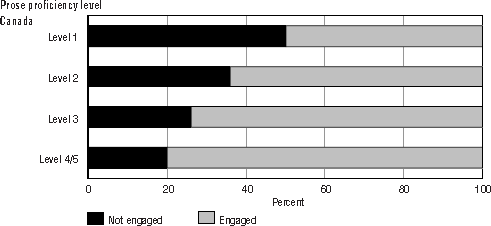
Figure 5.2
Note: Provincial and territorial distributions with standards errors are provided in Annex A Table 5.2.
Source: International Adult Literacy and Skills Survey, 2003.
Information and Communications Technologies (ICTs) have been a source of change for businesses, governments, and individuals. Within one generation, the means of transmitting information and interpersonal communication have changed dramatically. ICTs such as the personal computer and the Internet are so pervasive that they now mediate experience in many aspects of peoples’ lives (Fanning, 2001). Whether preparing a presentation at work, using an Internet search engine or communicating with family and friends using email or chat programs, Canadians have learned new skills and adapted others to use these technologies. Because ICTs are so common, the ability to use them effectively is becoming increasingly important, both to nations and individuals (Kirsch and Lennon, 2005). Indeed, the ability to use ICTs has become a key competency.
This section starts by briefly examining Canadians’ access to computers and the Internet, and then proceeds to an investigation of some of the factors related to ICT use. This includes an exploration of the relationships between ICT use and variables such as education, literacy proficiency and income for the population aged 16 to 65. Results are presented for Canada and the provinces and territories where possible1.
According to the survey results, three in four Canadians
(76 percent) aged 16 to 65
years have access to a computer at home. Among the six countries
participating in
the ALL survey,2 access rates are slightly higher only in
Norway (80 percent) and
Switzerland (83 percent). A majority of Canadians (68 percent)
also has an Internet
connection at home. Internet connectivity is somewhat higher
in Switzerland (75
percent) but similar in Norway (68 percent). Other studies
have shown that the
growth in home Internet connections stabilized in recent
years partly because as
penetration increased, the potential pool of new users became
smaller (Statistics
Canada, 2004).